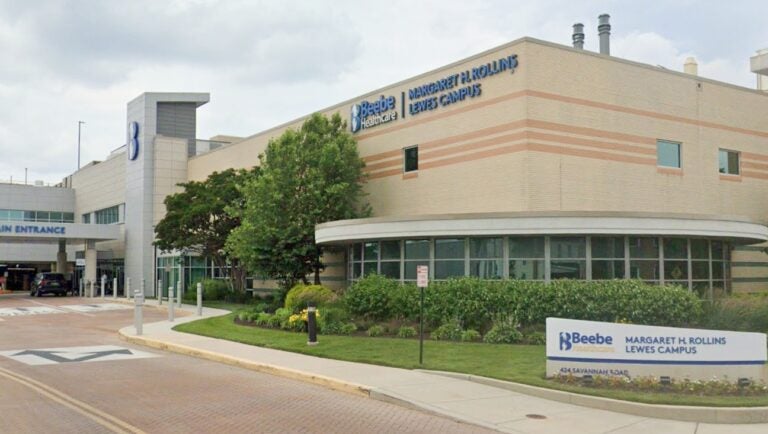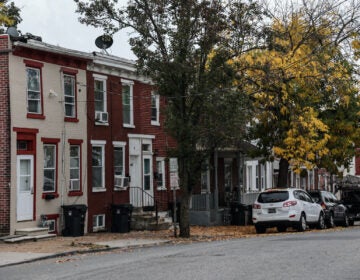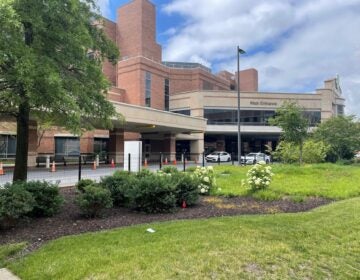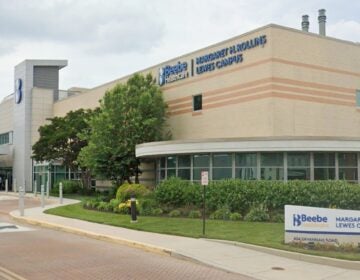Delaware health care systems struggling to keep pace with a rapidly growing older population
With seniors expected to make up a third of Delaware’s population by 2040, hospitals and clinics are expanding but still struggle with provider shortages and care delays.
Listen 5:04
The Beebe Healthcare hospital in Sussex County, Delaware. A feasibility study says no single health care system in the county — Beebe Healthcare, Bayhealth or TidalHealth — has enough resources on its own to support a medical school, but that one could be possible if the three systems combined resources. (Google Maps)
What are journalists missing from the state of Delaware? What would you most like WHYY News to cover? Let us know.
Delaware has quietly become one of the fastest-aging states in the country — a shift that’s reshaping the way health care is delivered across the First State. As more retirees settle in coastal communities and longtime residents grow older, the strain on hospitals, primary care providers and long-term care systems is mounting.
Currently, nearly 1 in 4 Delawareans is age 60 or older, and that number is climbing. Between 2006 and 2022, the number of residents over the age of 65 shot up by 61%. According to the state’s official plan on aging, adults aged 60 and older will make up almost 34% of Delaware’s population by 2040. Even more striking, the population of Delawareans aged 85 and older is projected to increase by more than 170% in the same time frame.
But the future isn’t just coming — it’s already here.
“We’re actually the eighth-oldest population in the country and we’re also the sixth-fastest growing in the country,” said Brian Frazee, president and CEO of the Delaware Healthcare Association. “Last year, Bankrate rated us the number one state in the country to retire because this is a great, great place to be.”
This dual reality — a population that’s aging fast and growing fast — is changing the demands on health care across all three counties.
“Our total state population is projected to increase by 9% before 2040, and the 85 and up population is expected to more than double in that time period,” Frazee said. “The 65 and up population would increase by more than 41%.”
Those numbers translate into real pressures inside hospitals and health care networks. Older adults tend to require more frequent care, and that means more doctors, more nurses and more services are needed, immediately and in the long term.
“It’s impacting us tremendously,” Frazee said. “We know that we utilize more health care services as we age, and that continues to increase the demand on our health care workforce in Delaware and the services that we’re able to provide.”
Expanding to meet the needs
Nowhere is that pressure more visible than in Sussex County, one of the fastest-growing destinations for retirees in the state. Beebe Healthcare, based in Lewes, has been working to stay ahead of the curve.
“We have seen an increase in the patient population down here in Sussex County over the last five years that I’ve been here … In Sussex County, we are predominantly a retirement community,” said David Tam, president and CEO of Beebe Healthcare. “The fact of the matter is our population is significantly older than populations in Kent and New Castle County. What that means then is if you are older, you require more health care. It’s just a fact of life. If you’re 65 and older, you require three times more health care than someone who’s 35.”
That demand isn’t just for acute care — it includes routine checkups, cancer screenings, bloodwork and other preventive services. To respond, Beebe has expanded its outpatient network, opening new facilities across the region.
“We opened up a new medical office building in Long Neck … We opened up another one in Milton … and we continue to grow in Selbyville and Millsboro,” he said, noting that it’s not only about meeting those in need the most, but also the workers. “Beebe Healthcare is moving out into the county, not just because the people need it, but because then our staff, our employed staff, our employees can live closer to where they work and be able to afford that.”
Still, staffing remains a critical challenge.
“Our community pharmacies close around 4 p.m. because there are not enough pharmacy techs or pharmacists,” Tam said. “We need more physical therapists, lab techs, rehab people.”
Access gaps are particularly acute in southern Delaware, where provider shortages and travel distance make care harder to reach, especially for older adults.
“One of the statistics that I put forward is that every physician, every provider that we have in the primary care arena has a much higher panel of patients than that same provider in New Castle or Kent or even Philadelphia,” he said. “What does that mean? That patients will have to wait longer, that these doctors have to work harder, and they’ll need the support staff. They need the nurses. They need the lab techs.”
Adapting care for older adults
Bayhealth, a health system that serves Kent and Sussex counties, is also seeing firsthand the impact of an aging population — and is shifting its approach accordingly.
“This is a more vulnerable population who, because of their age-related changes, might have more complexity to their care, and we want to make sure as an organization we’re meeting the needs of the community we’re serving,” said Felicia Cruz, the geriatric clinical nurse specialist.
To better serve older adults, Bayhealth has adopted a personalized approach, integrating NICHE practices, which stands for Nurses Improving Care for Healthsystem Elders. It’s also utilizing the 4Ms model, focusing on mentation, mobility, what matters and medications.
“We utilize their practices and principles to really improve the care for our older adults,” Cruz said. “In tandem with NICHE, Bayhealth has also adapted principles from the age-friendly health system and utilizing the 4M’s care model to really improve care outcomes for our older adult population.”
When the system falls short
For some Delaware residents, the cracks in the health care system aren’t just data points, they’re personal.
Ziulin Moreno, a 57-year-old Georgetown resident, said she has faced repeated challenges accessing care. Despite living near clinics like La Red Health Center, long wait times and limited provider availability have left her without timely treatment — even during emergencies.
“Bueno, fíjate que yo soy diabética. Entonces, yo vine y quise registrarme en La Red, orque es lo que tengo más cerca. Entonces, resulta que no pude registrarme porque la cita para que me pudieran ver por primera vez y todo aquello, me la dieron para enero”, ella dijo.
“Well, you see, I’m diabetic. So, I came and wanted to register at La Red, because it’s the closest place to me. So, it turns out I couldn’t register because the appointment for them to see me for the first time and everything was scheduled for January,” she said.
That monthslong wait left her vulnerable — and alone in critical moments.
“Yo tuve una emergencia médica y no pude conseguir que me atendieran. Inclusive tuve una emergencia también odontológica y tuve que buscar la manera de llegarle a alguien de las del directorio para que me pudieran atender la emergencia. Porque no había posibilidad. No había médicos y los pocos médicos tienen las agendas ocupadas”, dijo Moreno.
“I had a medical emergency and couldn’t get treatment. I even had a dental emergency, and I had to find a way to reach someone on the board so they could treat me. Because there wasn’t any way. There were no doctors, and the few doctors had full schedules,” Moreno said.
Her experience is common in southern Delaware, where a shortage of bilingual, culturally competent providers compounds existing care access issues.
“Necesitamos más consultas …, porque la gente va a pedir una consulta y se la dan para dentro de tres o cuatro meses. Eso no está bien … Porque las personas necesitan la atención médica preventiva a tiempo, no después”, ella dijo.
“We need more appointments … because people are going to ask for an appointment and they’re given one three or four months away. That’s not right … Because people need preventive medical care on time, not after the fact,” she said.
Seeking long-term solutions
As Delaware’s aging population continues to grow, state leaders, health systems and advocates are working to address the challenges. Hospitals are expanding, and groups like the Delaware Healthcare Association are pushing for structural reforms.
“We know that the governor and the General Assembly, the new Health Care Commission chair, are really interested in tackling this issue and working collaboratively with us to make sure we’re doing everything we can to increase primary care access in our state, because that’s very important,” Frazee said.
The solutions being explored include a statewide health care workforce scholarship program to recruit and retain providers, and incentives for clinical preceptors who train future nurses, doctors and specialists.
“Many states have enacted tax credits or provided grants to help incentivize more nurses,” he said. “We would like to look at doing that here in Delaware. We also would like to see more graduate medical education slots.”
This story was supported by a statehouse coverage grant from the Corporation for Public Broadcasting.

Get daily updates from WHYY News!
WHYY is your source for fact-based, in-depth journalism and information. As a nonprofit organization, we rely on financial support from readers like you. Please give today.











